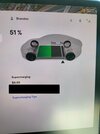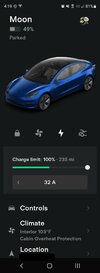Hi
I have a M3 LR Performance (20" wheels). I drive spiritedly. I have 42k miles on the car. I live in Texas where it's quiet warm. When I bought the car new , the 100% capacity was 310 miles. When I push the charging indicator to 100%, it shows my batt capacity is 280 miles , which is a 10% degradation.
Is this normal - Losing 10% in 42k miles ?
Thx
First of all, we are not talking about the range shown in the mobile app?
-
The mobile app do not show the correct range except in exception.
You need to check the range in the car, preferably by charging to 100%.
When was the delivery of the car?
I ask because it is the time that causes most degradation, not the miles.
What’s your charging habits?
You live in Texas, a hot climate.
Calendar aging is the dominant degratation source and hot climate increase this further.
If you keep the car at 80-90% SOC in a warm climate you should expect the degradation to be in the ball park of 7-8% the first year, maybe more if its a really hot climate with the car out in the sun.
Your car did probably have a battery capacity of around 77.8kWh when new.
I think that the range did not reduce until the capacity is down to 76kWh.
The capacity in the battery according to the current range (your 280mil) is about 68.5kWh.
That points to a loss of around 12%.
If you had 7% calendar aging after the first year, you would have reached 12% after three years. ( 7 x square root of 3)
-You would probably be at about 14% loss after 4 years and 19-20% after 8 years.
This is normal, it is the nature of the battery technology we have today.
The annual cyclic aging is probably less than 1%, (I assume 42K mi during 3 years).
Look at my post above for tips about reducing the degradation, if you dont like what you see today. Otherwise, just accept the fact that batteries age like we do.






